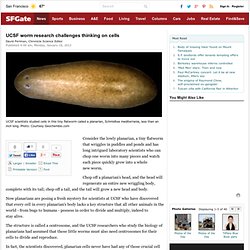

Www.crazyasabagofhammers.com - StumbleUpon. UCSF worm research challenges thinking on cells. Consider the lowly planarian, a tiny flatworm that wriggles in puddles and ponds and has long intrigued laboratory scientists who can chop one worm into many pieces and watch each piece quickly grow into a whole new worm.

Chop off a planarian's head, and the head will regenerate an entire new wriggling body, complete with its tail; chop off a tail, and the tail will grow a new head and body. Now planarians are posing a fresh mystery for scientists at UCSF who have discovered that every cell in every planarian's body lacks a key structure that all other animals in the world - from bugs to humans - possess in order to divide and multiply, indeed to stay alive. The structure is called a centrosome, and the UCSF researchers who study the biology of planarians had assumed that those little worms must also need centrosomes for their cells to divide and reproduce. Forget WiFi, Its LiFi: Internet Through Lightbulbs - Technology. Whether you’re using wireless internet in a coffee shop, stealing it from the guy next door, or competing for bandwidth at a conference, you’ve probably gotten frustrated at the slow speeds you face when more than one device is tapped into the network.
As more and more people—and their many devices—access wireless internet, clogged airwaves are going to make it increasingly difficult to latch onto a reliable signal. But radio waves are just one part of the spectrum that can carry our data. What if we could use other waves to surf the internet? One German physicist, Harald Haas, has come up with a solution he calls “data through illumination”—taking the fiber out of fiber optics by sending data through an LED lightbulb that varies in intensity faster than the human eye can follow. How to turn "water" into marbles. Amazing Trick - Video - StumbleUpon.